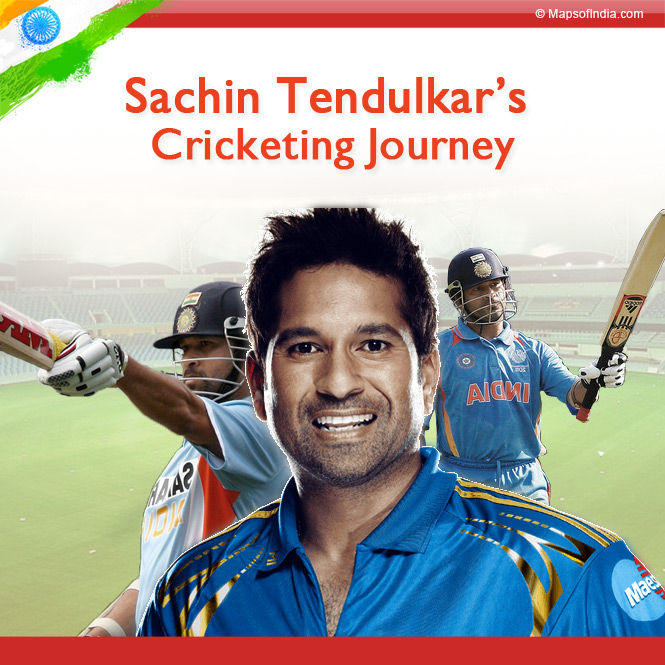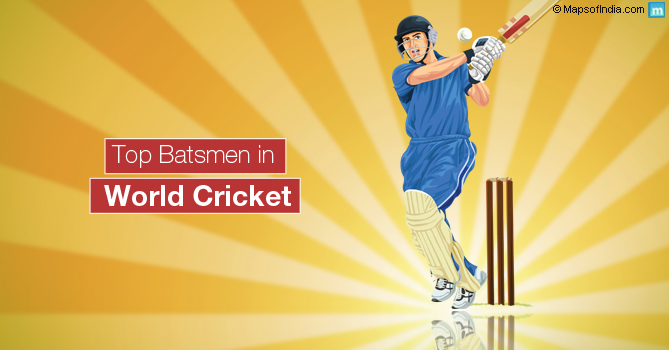Following his exploits in school cricket Sachin was selected to play for Mumbai in Ranji Trophy for the 1987-88 season. The date of selection was November 14, 1987. Sachin did not get to play in the first eleven any of the matches but was often deployed as a substitute fielder. He also missed out on a chance to share the field with Sunil Gavaskar, who was his idol and had called it quits after the 1987 World Cup. Sachin played his first match for Mumbai against Gujarat at his home ground on December 11, 1988. At that time he was only 15 years and 232 days old.
He made that match memorable by scoring an unbeaten innings of 100. This also made him the youngest Indian batsman to have scored a century in his first class debut. Before the match Sachin had netted with the Indian team at the Wankhede Stadium during a tour by the New Zealand team and had been comfortable against Kapil Dev who at that time was the best seamer in India. After seeing this he was picked by Dilip Vengsarkar, who was then the captain of Mumbai to play in this match. He also scored centuries in his first matches in the Deodhar Trophy and the Duleep Trophy.
In 1988-89 Tendulkar became the highest scorer for the Mumbai team. While playing for the Rest of India team during the 1989-90 season he scored a century against the Delhi team. He also toured England in 1988 and 1989 as a member of the Star Cricket Club.
The International Career Starts
Raj Singh Dungarpur is often given the credit for selecting Tendulkar for his first tour with the Indian team to Pakistan in 1989 and that too at a time when the Mumbai batsman had played just a solitary cricketing season. The Indian selection committee had been eyeing up Tendulkar and wanted him to tour the West Indies in 1988 itself but they did not choose him as they did not wish him to be exposed to the fearsome fast bowlers from the Caribbean Isles at that stage of his career.
Tendulkar played his first test in Karachi during November 1989 and at that time he was only 16 years and 223 days old. That match was also memorable as the debut match of Waqar Younis. Even though Sachin made just 15 runs the innings was noticeable for the way he was able to handle the fast bowling of the Pakistanis. During the final and fourth test of the series at Sialkot, Younis hit him on the nose with a bouncer. However, Sachin showed immense gumption with his willingness to carry on and refuse any medical help.
During that same series a 20 over exhibition match was organized at Peshawar and Sachin scored a fantastic 53 from just 18 balls and took apart Abdul Qadir, the legendary leggie. In one over from Qadir, Sachin smashed 27 runs. Krishnamachari Srikkanth, then the captain of the Indian team, calls it one of the better innings he has seen. Tendulkar finished the series with an average of 35.83 and 215 runs.
India next went on a tour to New Zealand where he got 117 runs in the tests with an average of 29.25 and this included a score of 88 in the 2nd test. When India toured England during July and August 1990, he achieved the honor of being the 2nd youngest batsman to have scored a century in tests when he notched up an unbeaten innings of 119 in the second test held at Old Trafford, Manchester. Wisden has rated the innings very highly saying it combined a lot of maturity and discipline. His technique and command against the seamers of England was praised as well.
Tendulkar carved a bigger name for himself during India’s tour to Australia in 1991-92. He scored a 148 not out in the 3rd test that was held at Sydney and then made 114 on Perth, which had a very quick and bouncy surface. The quality of these runs could be understood from the fact that at that time Australia had a fantastic fast bowling line up with the likes of Craig McDermott, Bruce Reid and Merv Hughes. It is also said that at that time Hughes had told Allan Border that Sachin will one day score more runs than him.
The Period between 1994 and 1997
The period from 1994 to 1997 came when Sachin was in the pink of his health. He was in his early 20s then and grown up from the precocious teen who had taken the world by storm in the early 90s with his breathtaking batsmanship. Sachin went out to open the batting for the first time in one day games at Auckland against the hosts New Zealand in 1994. He carved 82 from just 49 deliveries. Soon Sachin scored his first century in the one day matches on September 9, 1994 in Colombo against the Aussies. His first ODI century had come after 79 matches. This, in a way, was a sign of things to come.
Tendulkar continued to perform well in the 1996 World Cup as well and became the highest scorer in the tournament with a couple of centuries to his name. In that World Cup he was also the only batsman to have performed in the infamous semi final against the Sri Lankans when the match was awarded to the eventual champions after the crowd threw things on to the ground following an inept display by the Indian batsmen.
Following the World Cup India played a tournament in Sharjah where in one match against Pakistan Tendulkar and Sidhu scored centuries and got the highest 2nd wicket partnership in ODIs at that time. This partnership also helped India post a score of 300 for the first time in ODIs. India was victorious in that match and earned the right to play South Africa in the final.
1998 was one of the major years in the cricketing career of Sachin Tendulkar considering the amount of runs he scored and how these scores contributed to India’s victory. It all began with the domination of Shane Warne and the Australian team when they toured for a series of 3 tests. Sachin stamped his authority in the series with 3 hundreds and regularly charged at the Aussie spinners and carted them over the infield. He prepared for the series by practising against Laxman Sivaramakrishnan, a leg spinner who had represented India with great success during the late 80s. It was also on this tour that Sachin appeared for the Mumbai team in a side game against Australia and hammered his first double century in first class cricket. This inning also played a major role in denting Australia’s confidence before the test series began.
Tendulkar’s domination of Warne was such that the leg spinner admitted that he had nightmares of Sachin coming down and hitting him out of the ground. In the ensuing tri series that also involved Zimbabwe, Sachin performed well with both ball and bat. However, the pinnacle of the year came in Sharjah when Sachin notched up a pair of centuries against Australia to first take his team to the final and then win it. These centuries are famous in cricketing folklore as ‘desert storm’. He also repeated the dosage in the quarterfinal of the first ever ICC Knockout Trophy held in Dhaka by scoring 141 runs and then taking 4 wickets.
1999
1999 was an important year in Sachin’s career as well. While playing against Pakistan in Chennai the Little Master scored a determined century ignoring tremendous back pain but when he got out the team collapsed as well and Tendulkar’s fine innings was rendered useless due to the ineptitude of his team mates.
The 1999 World Cup coincided with a purple patch being enjoyed by Sachin and the whole country was hopeful India would be finally be able to win the trophy that had eluded them for 16 years owing to Sachin’s form. However, disaster struck during the tournament and Ramesh Tendulkar, his father, passed away. Sachin missed the match against Zimbabwe and flew back to his home to attend his father’s funeral. However, he came back when his mother asked him to go back and play for his country as that was what his father would have wanted as well. He returned and smashed a century against Kenya to kickstart India’s comeback in the campaign that eventually saw the team progress to the Super 6 stage.
2000 onwards
In 2000 Sachin became the captain of India for the second time. He had previously captained the national team back in 1996 and 97 but apart from a series against Pakistan in Canada the results had never really gone in his favor. This time too things were no different. Sachin won at home against New Zealand and then went to Australia where the new world champions decimated them. India came back home and lost 2-0 to South Africa in a two test series. Following this, he tendered his resignation as the captain and the reins were taken over by Sourav Ganguly.
During 2001 and 2002 Sachin performed well as usual for India with both bat and ball. His performances in test cricket stood out during this phase of his career. During the 2nd test against Australia in 2001, held at Eden Gardens Kolkata, Tendulkar picked up Adam Gilchrist and Matthew Hayden, to hasten India’s triumph.
India visited West Indies for a series in 2002. During this tour Sachin scored a century to equal the record of 29 centuries set by Sir Donald Bradman. However, this series also saw him get a string of low scores often owing to technical problems as well as bad stroke-making that was not really associated with him. He passed Bradman’s record in England during August 2002 when India toured the country after the series versus the Windies. It was also his 99th test match.
2003 – World Cup and thereafter
The 2003 World Cup was a successful tournament for India and the Little Maestro played an important role in that with 673 runs from 11 games. Even though India was plastered by Australia in the finals, Sachin received the Man of the Tournament prize for his exploits throughout the tournament.
His form in ODI cricket was exceptional in that year as he scored a couple of hundreds in a tri series that also involved Australia and New Zealand. India toured Australia in 2003-04 and drew the series. In the final test of the series Sachin scored 241 not out that was exceptional for the amount of control he showed – he did not play a single cover drive in that innings and accumulated his runs in a safe way thus thwarting Aussie plans to lure him into getting out. This innings also helped him to bounce back to form after enduring a terrible year in tests in 2003 with a solitary 50 and an average of 17.25.
India toured Pakistan in 2004 where he set the tone for the series with a tremendous 194 not out at the very first test in Multan. Tendulkar then missed the majority of 2004 with tennis elbow and this raised some serious aspersions as to whether he could continue any longer. He came back in the series against Australia in 2004 and played a pivotal role in India winning the final test at Mumbai and salvaging some honor.
2005 and 2006 – the hard times
Sachin scored the 35th test century of his career thus setting a new world record for test centuries. He achieved this on December 10, 2005 against the Sri Lankans at Firoz Shah Kotla. After this, Sachin endured a lean patch where he did not get any century in test cricket. In fact he scored his next test century against Bangladesh during May 2007. 2006 was a mixed period as Sachin scored well in ODI cricket with centuries against Pakistan and West Indies but not doing so well in the tests.
More to come soon. Stay tuned . . .
Read More about Sachin Tendulkar:
Sachin Tendulkar Biography
Playing It My Way Book Review: Sachin Tendulkar’s Autobiography
Top 10 Batsmen in the World of Cricket
Sachin Tendulkar: One of a kind
Who can break Sachin’s record?
Sachin Tendulkar and nervous 90s: just bad luck or more?
Was Sachin a Selfish Player?
Is Sachin an excuse for the BCCI?
The other side of Sachin Tendulkar
Sachin Tendulkar against spin bowling
Sachin Tendulkar against fast bowling
Sachin Tendulkar’s Cricketing Journey
Unforgettable Moments of Sachin’s career
Sachin as the next coach of India
Sachin Tendulkar Records
Childhood of Sachin Tendulkar
Journey of Sachin Tendulkar





